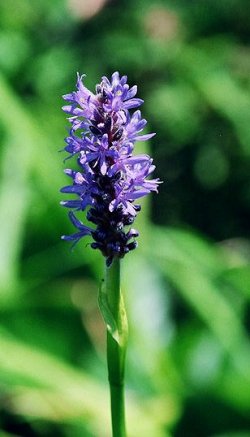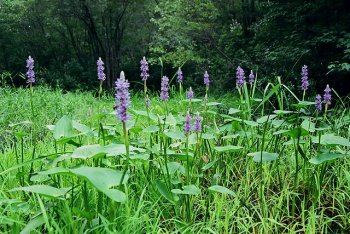Pontederia cordata
  |
 |
Photos Courtesy Renee Brecht |
Britton & Brown |
| Botanical name: | Pontederia cordata |
| Common name: | Pickerelweed |
| Group: | monocot |
| Family: | Pontederiaceae |
| Growth type: | forb/herb |
| Duration: | perennial |
| Origin: | native |
| Plant height: | 1 - 4' |
| Foliage: | Large, waxy, up to 5" wide, and usually twice as long; leaf shape variable, but typically lance-shaped. The leaves are long-petioled (petioles averaging 4.5 cm.). The multiple veins of the leaves are orientated in a parallel arrangement starting at the base. However, rosettes of submerged, ribbon-like leaves can also be produced. |
| Flower: | Spike of violet-blue flowers with two yellow spots. Sometimes the flowers are white. |
| Flowering time: | late June to mid-September |
| Habitat: | Muddy shores or shallow water |
| Range in New Jersey: | Frequent in water along streams
throughout the state, extending well back into the heart of the Pine
Barrens. |
| Heritage ranking, if any: | n/a |
| Distribution: |  |
| Misc. | USDA
lists as Obligate, i.e., Almost always occurs in wetlands (estimated probability > 99%)
under natural conditions The variety angustifolia Pursh seems to be merely an extreme leaf from such as we find in Sagittaria and other aquatic plants (Stone, 327). Pickerel Weed, from attraction of young pike (Esox lucius) to its underwater roots for cover. Pickerelweed is rhizotamous and a colonizer. Pollinated by bees. According to Elias. T. and Dykeman. P. Field Guide to N. American Edible Wild Plants, and Facciola. S. Cornucopia - A Source Book of Edible Plants, Seeds can be eaten raw, cooked like rice or dried and ground into a powder. Young leafstalks are edible raw or cooked. Pontederia after Guilio Pontedera, 1688-1756, professor of botany at Padua; cordata, heart shaped (refering to the leaves). |